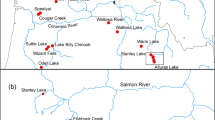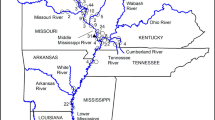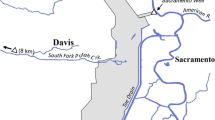Abstract
Burbot Lota lota maculosa numbers in Kootenay Lake and Kootenai River of British Columbia, Idaho, and Montana have diminished due to habitat changes from the construction of Libby Dam. Recent implementation of a conservation strategy included aquaculture to supplement the population using a donor stock from a self-sustaining lake population within the watershed. Evaluation of release strategies using telemetry and mark recapture through hoop netting suggests lake-origin Burbot have adapted to the Kootenai system and selected riverine over lacustrine habitat. Previous telemetry work identified good survival and dispersal of released Burbot, and vast dispersal distance and lacustrine use. However, our analysis of a broader telemetry dataset indicated that only 24% of age 1–4 Burbot were detected in the lake. Recapture hoop net data indicated that Burbot residing in the river have growth and survival rates comparable to the historical population. Spawning of hatchery origin fish was detected at historical riverine spawning locations. Other than later spawn timing, our evaluations suggest lake-origin fish are mimicking movement and habitat use of the historical riverine population. This study, in combination with others, provides evidence that Burbot progeny from lacustrine brood stock can successfully survive, grow, disperse, and spawn in a riverine environment.






Similar content being viewed by others
References
Anderson, E. C. & J. C. Garza, 2005. The power of single-nucleotide polymorphisms for large-scale parentage inference. Genetics 172: 2567–2582.
Arndt, S. K. A. & J. Hutchinson, 2000. Characteristics of a tributary-spawning population of Burbot from Columbia Lake, British Colombia. In Paragamian, V. L. & D. W. Willis (eds), Burbot: biology, ecology, and management. American Fisheries Society, Fisheries Management Section, Publication Number 1, Bethesda: 48–60.
Bonde, T. H., & R. M. Bush, 1975. Kootenai River water quality investigations, Libby Dam pre-impoundment study 1967–1972. U.S. Army Corps of Engineers.
Chen, L. C., 1969. The biology and taxonomy of the Burbot, Lota lota leptura, in interior Alaska. Biological Papers of the University of Alaska 11: 1–53.
Crook, D. A., 2004. Is the home range concept compatible with the movements of two species of lowland river fish? Journal of Animal Ecology 73: 353–366.
Dillen, A., I. Vught, D. De Charleroy, D. Monnier & J. Coeck, 2008. A preliminary evaluation of reintroductions of Burbot in Flanders, Belgium. In Paragamian, V. L. & D. H. Bennett (eds), Burbot ecology, management, and culture. American Fisheries Society, Symposium 59, Bethesda: 179–183.
Dunnigan, J. L. & C. L. Sinclair, 2008. Home range and movement patterns of Burbot in Koocanusa Reservoir, Montana. In Paragamian, V. L. & D. H. Bennett (eds), Burbot Ecology, Management, and Culture. American Fisheries Society, Symposium 59, Bethesda: 43–54.
Ebner, B. C. & J. D. Thiem, 2009. Monitoring by telemetry reveals differences in movement and survival following hatchery or wild rearing of an endangered fish. Marine and Freshwater Research 60: 45–57.
Evenson, M. J., 1993. A summary of abundance, catch per unit of effort, and mean length estimates of Burbot sampled in rivers of interior Alaska. Alaska Department of Fish Game, Fisheries Data Series 93–15, Anchorage.
Evenson, M.J. & P. Hansen, 1991. Assessment of harvest characteristics of Tanana River Burbot sport fishery in 1990 using a postal questionnaire. Alaska Department of Fish and Game, Fishery Data Series No. 91-67, Anchorage.
Hardy, R. S., 2003. Kootenai River Fisheries Recovery Investigations: Ecosystem Rehabilitation. Annual Progress Report. April 1, 2002-March 31, 2003. IDFG Report Number 04-01. Idaho Department of Fish and Game, Boise, ID.
Hardy, R. & V. L. Paragamian, 2013. A synthesis of Kootenai River Burbot stock history and future management goals. Transactions of the American Fisheries Society 142: 1662–1670.
Ireland, S. & P. Perry, 2008. Burbot restoration in the Kootenai River Basin: using agency, tribal, and community collaboration to develop and implement a conservation strategy. In Paragamian, V. L. & D. Bennett (eds), Burbot: Ecology, Management, and Culture. American Fisheries Society, Symposium 59, Bethesda: 251–256.
Jones, G. P., 1991. Post recruitment processes in the ecology of coral reef fish populations: a multifactorial perspective. In Sale, P. F. (ed.), The Ecology of Fishes on Coral Reefs. Academic Press, San Diego, CA: 294–398.
Jensen, N. J., S. C. Ireland, J. T. Siple, S. R. Williams & K. D. Cain, 2008. Evaluation of egg incubation methods and larval feeding regimes for North American Burbot. North American Journal of Aquaculture 70: 162–170.
Katzman, L. M. & A. V. Zale, 2000. Age and growth of an exploited Burbot population in Upper Red Rock Lake, Montana. In Paragamian, V. L. & D. W. Willis (eds), Burbot: biology, management, and ecology. American Fisheries Society, Fisheries Management Section, Publication Number 1, Bethesda, MA: 139–146.
Kozfkay, J. R. & V. L. Paragamian, 2002. Kootenai River Fisheries Investigation: Burbot Stock Status. Annual Progress Report, Project 88-65. Idaho Department of Fish and Game, Boise.
KVRI (Kootenai Valley Resource Initiative) Burbot Committee, 2005. Kootenai River/Kootenay Lake Burbot conservation strategy. Prepared by the Kootenai Tribe of Idaho with assistance from S. P. Cramer and Associates, Bonners Ferry.
Lafferty, R., J.F. Parker, & D.R. Bernard, 1991. Stock assessment and biological characteristics of Burbot in lakes of interior Alaska during 1989. Alaska Department of Fish and Game, Fishery Data Series No. 91-57, Juneau.
McPhail, J. D. & V. L. Paragamian, 2000. Burbot biology and life history. In Paragamian, V. L. & D. W. Willis (eds), Burbot: biology, management, and ecology. American Fisheries Society, American Fisheries Society, Fisheries Management Section, Publication Number 1, Bethesda, MA: 11–23.
Minns, C. K., 1995. Allometry of home range size in lake and river fishes. Canadian Journal of Fisheries and Aquatic Sciences 52: 1499–1508.
Neufeld, M. D., 2008. Moyie Lake Burbot: population assessment 2007. Ministry of Environment Report, Nelson, BC.
Neufeld, M. & C. Spence, 2007. Evaluation of a simple decompression procedure to reduce decompression trauma in trap caught Burbot. Transactions of the American Fisheries Society 133: 1260–1263.
Neufeld, M. & P. Rust, 2009. Using passive sonic telemetry methods to evaluate dispersal and subsequent movements of hatchery-reared white sturgeon in the Kootenay River. Journal of Applied Ichthyology 25: 27–33.
Neufeld, M. D., K. D. Cain, N. R. Jensen, S. C. Ireland & V. L. Paragamian, 2011. Movement of lake-origin Burbot reared in a hatchery environment and released into a large river drainage. North American Journal of Fisheries Management 31: 56–62.
Paragamian, V. L. & M. J. Hansen, 2009. Rehabilitation needs for Burbot in the Kootenai River, Idaho, USA and British Columbia, Canada. North American Journal of Fisheries Management 29: 768–777.
Paragamian, V. L., V. Whitman, J. Hammond & H. Andrusak, 2000. Collapse of the Burbot fisheries in Kootenay Lake, British Columbia, Canada, and the Kootenai River, Idaho, USA, post-Libby Dam. In Paragamian, V. L. & D. W. Willis (eds), Burbot: Biology, Ecology, and Management. American Fisheries Society, Fisheries Management Section, Publication Number 1, Bethesda: 155–164.
Paragamian, V. L., S. Yundt, J. Hammond, C. Spence, S. Ireland, G. Hoffman & J. Laufle, 2002. An International Recovery Strategy for Burbot in the Kootenai River and Kootenay Lake, Idaho and British Columbia. Intermountain Journal of Science 8: 178–190.
Parker, J.F., W.D. Potterville, & D.R. Bernard, 1988. Stock assessment and biological characteristics of Burbot in lakes of interior Alaska during 1987. Alaska Department of Fish and Game. Fishery Data Series No. 65.
Partridge, F., 1983. Kootenai River fisheries investigations. Idaho Department of Fish and Game Federal Aid to Fish and Wildlife Restoration Job Completion Report F-73-R-5, Boise.
Powell, M., V. L. Paragamian & J. Dunnigan, 2008. Mitochondrial variation in Western North American Burbot with special reference to the Kootenai River in Idaho and Montana, USA. In Paragamian, V. L. & D. H. Bennett (eds), Burbot: ecology, management, and culture. American Fisheries Society, Symposium 59, Bethesda: 3–28.
Prince, A., 2007. East Kootenay Burbot population assessment. Westslope Fisheries, Cranbrook, BC.
Sandlund, O. T., L. Klyve & T. F. Naesje, 1985. Growth, habitat and food of Burbot, Lota lota, in Lake Mjosa. Fauna 38: 37–43.
Schram, S. T., 2000. Seasonal movement and mortality estimated of Burbot in Wisconsin waters of western Lake Superior. In Paragamian, V. L. & D. W. Willis (eds), Burbot: Biology, Ecology, and Management. American Fisheries Society, Fisheries Management Section Publication 1, Spokane, WA: 90–95.
Sorokin, V. N., 1971. The spawning and spawning grounds of the Burbot, Lota lota (L.). Journal of Ichthyology 11: 907–916.
Stapanian, M., V. L. Paragamian, C. P. Madenjian, J. R. Jackson, J. Lappalainen, M. J. Evenson & M. D. Neufeld, 2010. Worldwide status of Burbot and conservation measures. Fish and Fisheries 11: 34–56.
Steele, C. & M. Campbell, 2011. Parentage based tagging of Snake River hatchery steelhead and Chinook salmon. Idaho Department of Fish and Game. 2010 Annual Progress Report, IDFG Report Number 11-111.
Stephenson, S., M. Neufeld, S. Young, S. Ireland, R. Hardy & P. Rust, 2013. Survival and dispersal of sonic-tagged hatchery-reared Burbot released into the Kootenai River. Transactions of the American Fisheries Society 142: 1671–1679.
Taylor, J. L. & J. D. McPhail, 2000. Temperature, development, and behavior in the early life history of Burbot from Columbia Lake, British Columbia. In Paragamian, V. L. & D. W. Willis (eds), Burbot: Biology, Management, and Ecology. American Fisheries Society, Fisheries Management Section, Publication Number 1, Bethesda, MA: 30–37.
Worthington, T., I. Vught, D. De Charleroy, P. Kemp, J. Coeck, P. Osborne & K. Easton, 2009. The re-introduction of the Burbot to the United Kingdom and Flanders. In Soorae, P. S. (ed.), Global Re-Introduction Perspectives: Re-Introduction Case-Studies from Around the Globe. International Union for Conservation of Nature/Species Survival Commission, Re-introduction Specialist Group, Abu Dhabi: 26–29.
Acknowledgments
Special thanks to Sue Ireland, Chris Lewandowski, Jose Ponce, Desi Aitken, and others of the KTOI hatchery staff. Thanks to Don Miller of Kootenay Wildlife Services and Valerie Evans from British Columbia Ministry of Forests, Lands and Natural Resource Operations. Thanks to Dr. Ken Cain, Patrick Blaufuss, Joe Evavold, Nate Jensen, Neil Ashton, and Josh Eagan of the UIARI. We wish to thank the KTOI members for sponsorship of Burbot culture studies at UIARI. Thanks to Shaun Lacy, Brian Simmons, Cathy Gidley, T.J. Ross, Pete Rust, and Corie Laude with the IDFG for their river sampling efforts. We would also like to thank Dr. Dan Schill and Jim Fredericks with IDFG for their helpful suggestions throughout this paper. We thank the Kootenai Valley Resource Initiative for Burbot restoration efforts in collaboration with many agencies. Bonneville Power Administration provided the funding for this study and all ongoing Burbot restoration in the basin.
Author information
Authors and Affiliations
Corresponding author
Additional information
Guest editors: Martin A. Stapanian & Christopher A. Myrick / Ecology, Culture, and Management of Burbot
Rights and permissions
About this article
Cite this article
Hardy, R.S., Stephenson, S.M., Neufeld, M.D. et al. Adaptation of lake-origin burbot stocked into a large river environment. Hydrobiologia 757, 35–47 (2015). https://doi.org/10.1007/s10750-015-2226-0
Received:
Revised:
Accepted:
Published:
Issue Date:
DOI: https://doi.org/10.1007/s10750-015-2226-0




